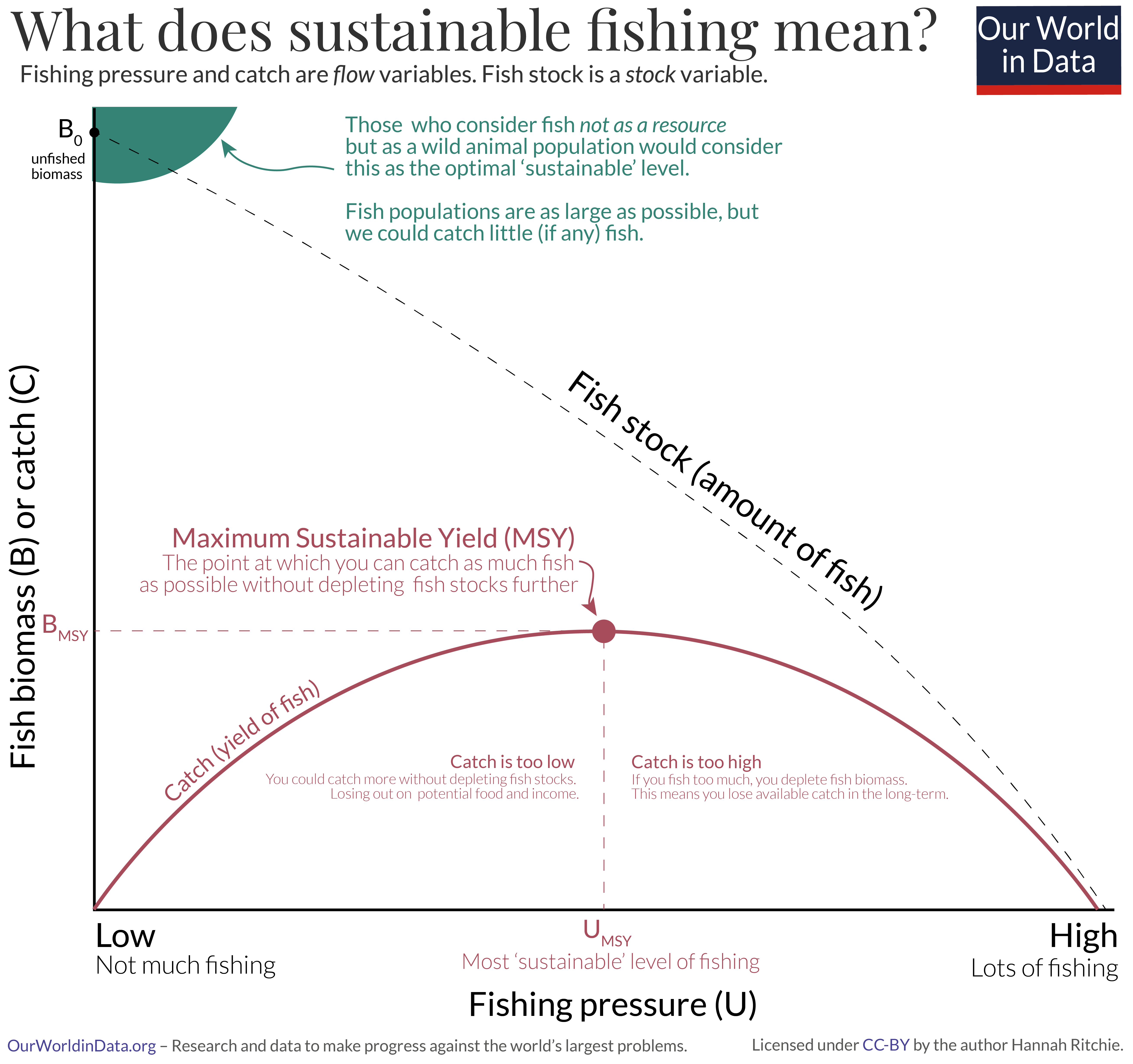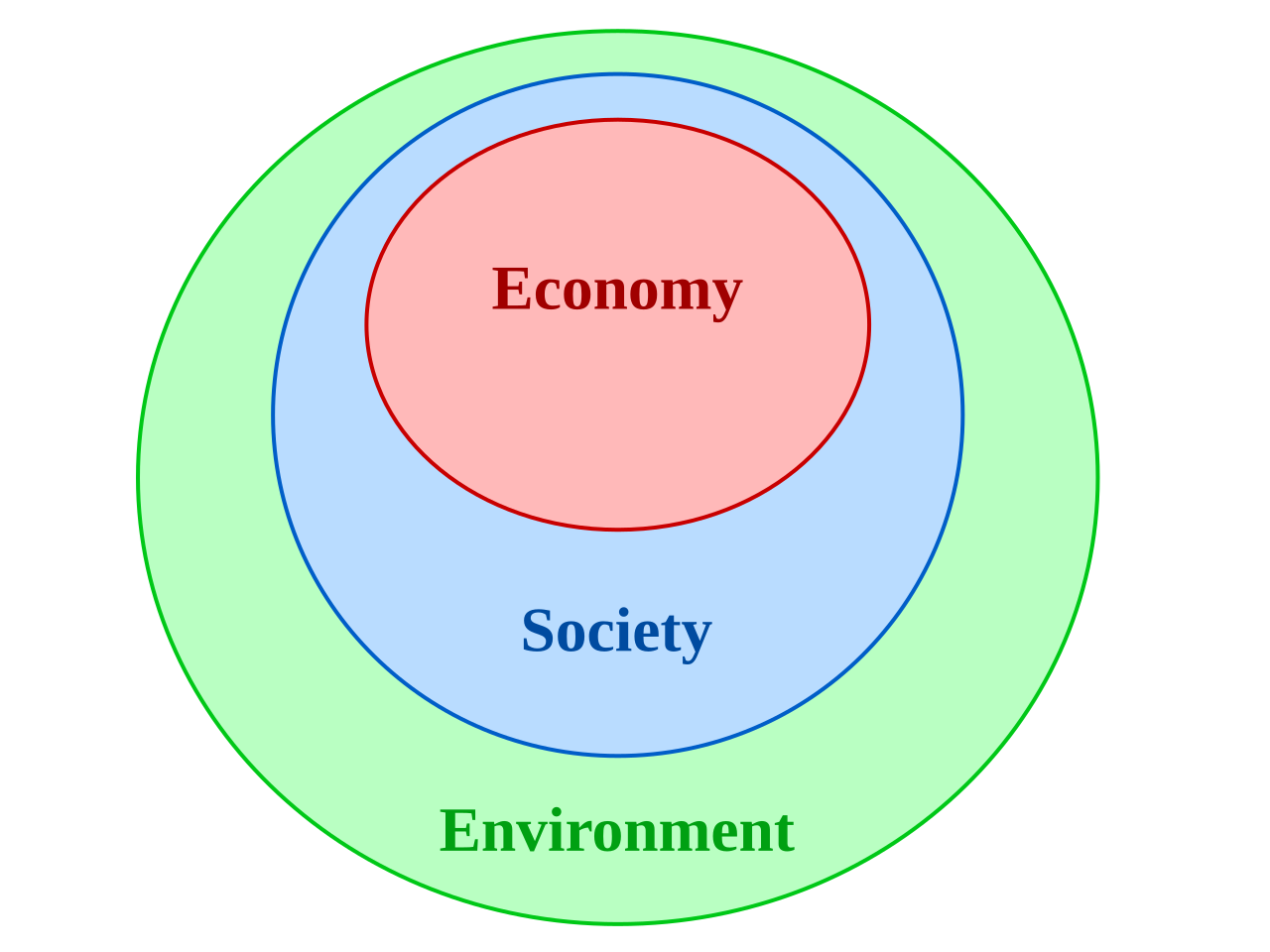IB Syllabus focus:
‘Environmental sustainability manages resources for renewal and ecosystem recovery; social sustainability builds health, education, equity, community; economic sustainability meets needs over time—ultimately dependent on environmental sustainability.’
Sustainability requires balance between environmental, social, and economic systems. Each dimension supports long-term stability, but without environmental sustainability, neither social nor economic development can endure.
Environmental Sustainability
Environmental sustainability focuses on the renewal of natural resources and the maintenance of ecological balance to prevent long-term ecosystem collapse.
Key Features
Resource management: Using renewable resources at or below their natural regeneration rate.

This diagram plots fishing pressure against fish stock and catch, labelling the maximum sustainable yield (MSY) — the “sweet spot” where long-term catch is maximised without reducing population levels. It exemplifies managing renewable resources at or below regeneration rates, directly supporting environmental sustainability in your notes. The figure includes fishery-specific detail beyond the syllabus to clarify the resource-management concept. Source.
Ecosystem recovery: Allowing habitats and species populations to restore after disturbance.
Pollution control: Limiting emissions, waste, and toxins to levels ecosystems can absorb.
Biodiversity conservation: Protecting species and genetic diversity to maintain resilience.
Environmental Sustainability: The ability of natural systems to continue providing resources and ecological services without permanent degradation.
One central principle is that human economic systems are embedded within environmental limits, making environmental sustainability the ultimate foundation for the other two pillars.
Social Sustainability
Social sustainability ensures societies remain healthy, equitable, and cohesive over generations. It focuses on improving quality of life while respecting environmental boundaries.
Core Elements
Health: Providing access to clean water, sanitation, healthcare, and safe environments.
Education: Ensuring knowledge transfer, skills development, and awareness of environmental responsibilities.
Equity: Reducing disparities in wealth, gender, and opportunity.
Community cohesion: Promoting cultural identity, inclusion, and social stability.
Social Sustainability: The maintenance and improvement of social quality, including equity, cohesion, and well-being, across present and future generations.
Without adequate education and health, populations cannot participate fully in economic or environmental decision-making. Therefore, social sustainability strengthens resilience and supports responsible stewardship of ecosystems.
Economic Sustainability
Economic sustainability ensures that goods, services, and resources are provided in ways that remain viable over time. However, it is dependent on environmental sustainability for raw materials and ecosystem services.
Key Aspects
Meeting present needs: Supplying food, water, and materials for current populations.
Future security: Preserving capital, resources, and innovation capacity for future generations.
Efficiency and productivity: Reducing waste and maximising use of renewable resources.
Interdependence: Recognising that unchecked growth undermines ecological systems, which in turn damages long-term economic stability.
Economic Sustainability: The ability of an economy to support present and future generations by balancing growth, resource use, and environmental limits.
Economic sustainability is only possible if ecosystems can renew the resources on which industries and societies depend.
Interdependence of the Three Dimensions
The Hierarchical Relationship
While the three pillars are often depicted as equal, the IB syllabus emphasises that economic sustainability ultimately depends on environmental sustainability.

Concentric circles show the economy nested within society, both contained by the environment, highlighting environmental limits as the foundation for long-term social and economic sustainability. This model directly supports the syllabus emphasis on dependency across the three dimensions. Source.
Interconnections
Environmental → Social: Clean air, safe water, and fertile soil sustain communities.
Social → Economic: Healthy, educated populations strengthen economies.
Economic → Environmental: Resource extraction and production can degrade ecosystems unless regulated.
This interdependence shows that sustainability is not just about balancing goals, but about recognising foundational limits set by the environment.
Indicators of Sustainability
To evaluate sustainability, scientists and policymakers use measurable indicators that reflect environmental, social, and economic conditions. Common measures include:
Environmental Indicators
Carbon emissions: Levels of greenhouse gases contributing to climate change.
Biodiversity indexes: Numbers of species and habitat health.
Renewable resource use: Rates of forest, fish, or freshwater regeneration.
Social Indicators
Literacy rates and school enrolment: Reflecting education access.
Life expectancy and health outcomes: Indicators of well-being.
Equality measures: Gender parity, income distribution.
Economic Indicators
GDP per capita: A traditional but limited measure of economic output.
Green GDP: Adjusted for environmental costs and resource depletion.
Employment rates: Reflecting social and economic stability.
Indicators must be interpreted together to assess whether societies are meeting needs without undermining future capacity.
Sustainable Development
The concept of sustainable development integrates all three pillars, aiming to balance human progress with ecological responsibility. It links directly to the Brundtland Report definition: meeting the needs of the present without compromising future generations.
Unlike economic growth alone, sustainable development requires that environmental limits guide human ambitions.
Bullet-pointed actions for sustainable development include:
Encouraging renewable energy use.
Supporting social policies that improve education and healthcare.
Designing economic policies that account for environmental costs.
Challenges to Achieving Sustainability
Despite clear frameworks, achieving balance across the three pillars is difficult:
Environmental challenges: Overexploitation, pollution, and biodiversity loss.
Social challenges: Inequalities in wealth, access, and political power.
Economic challenges: Dependency on short-term growth models rather than long-term planning.
Global cooperation is needed to align environmental protection, social equity, and economic stability, but conflicts of interest often slow progress.
FAQ
Weak sustainability assumes natural capital (environmental resources) can be substituted with human-made capital. Strong sustainability argues that natural capital is irreplaceable and must be preserved.
This distinction matters because ecosystems provide unique services, such as climate regulation and nutrient cycling, that cannot be replicated by technology or money.
Environmental sustainability directly shapes trade policies, as overuse of resources in one region can affect global supply chains.
Sustainable fisheries agreements regulate catch levels across nations.
Certification schemes like FSC (Forestry Stewardship Council) influence timber trade.
Unsustainable practices often lead to restrictions, tariffs, or loss of consumer trust.
Cultural diversity supports social sustainability by strengthening community identity and fostering inclusivity.
When multiple cultural perspectives are respected, societies are better equipped to manage conflicts, build resilience, and encourage equitable participation in decision-making.
This reduces marginalisation and helps communities remain cohesive in the face of environmental or economic stress.
Green technologies allow economies to grow without exhausting natural systems.
Examples include:
Renewable energy reducing dependence on fossil fuels.
Circular economy innovations such as recycling and material recovery.
Energy-efficient infrastructure lowering long-term costs while conserving resources.
By reducing environmental strain, these technologies ensure long-term economic viability.
Governments increasingly use composite indices that capture quality of life and equity.
Examples include:
Human Development Index (HDI): combines life expectancy, education, and income.
Gini coefficient: measures income inequality.
Social Progress Index: assesses health, education, and rights.
These measures highlight dimensions of well-being often overlooked by GDP alone.
Practice Questions
Question 1 (2 marks):
Define social sustainability and give one example of how it can be promoted within a community.
Mark scheme:
1 mark for correctly defining social sustainability: e.g. “maintenance and improvement of social quality, including equity, cohesion, and well-being, across present and future generations.”
1 mark for a valid example: e.g. access to education, healthcare provision, or policies promoting equity.
Question 2 (5 marks):
Explain how the three dimensions of sustainability (environmental, social, and economic) are interdependent, and why environmental sustainability is considered the foundation for the other two.
Mark scheme:
1 mark for explaining environmental sustainability (resource management, ecosystem recovery, biodiversity).
1 mark for explaining social sustainability (health, education, equity, cohesion).
1 mark for explaining economic sustainability (meeting needs, efficiency, dependence on environment).
1 mark for showing interdependence between at least two dimensions (e.g. environmental health supports communities, educated populations support economies, unchecked growth damages ecosystems).
1 mark for stating clearly that environmental sustainability underpins both social and economic sustainability, as without healthy ecosystems neither society nor the economy can function.

